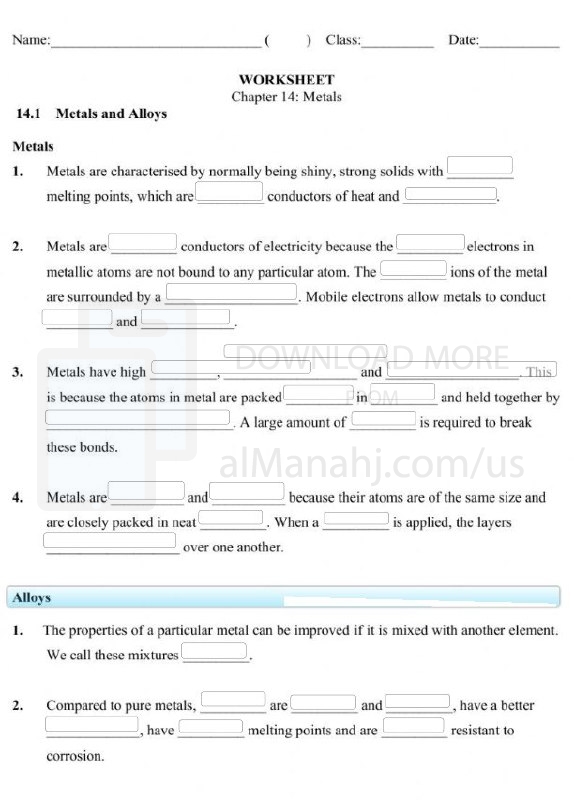| You are here: Almanahj Website ⇒ American curriculum ⇒ 9th Grade ⇒ Chemistry ⇒ Term 1 | ||
|---|---|---|
Worksheet about Metal properties and reactivity and extraction and rusting | ||
|---|---|---|
| Subject: Chemistry | ||
| 9th Grade | ||
| Term 1 | ||
| Year: 2023/2024 | ||
| Size: 1MB | ||
| Number of clicks: 89 | ||
| Publish date:November 06, 2023 | ||
| Added by: Eman | ||
| Last download date: 2024-09-11 05:55:27 | ||
| Updated by: Eman9966 on 2023-11-06 06:24:22 | By: theodor clementyew | |
| File info: Metals are a group of chemical elements that exhibit certain characteristic properties. Some of the key properties of metals include:1. Luster: Metals have a shiny appearance due to their ability to reflect light. 2. Conductivity: Metals are good conductors of heat and electricity. They have a high electrical and thermal conductivity, allowing them to transfer heat and electricity efficiently. 3. Malleability: Metals can be easily hammered or rolled into thin sheets without breaking. This property is known as malleability. 4. Ductility: Metals can be drawn into thin wires without breaking. This property is called ductility. 5. High Melting and Boiling Points: Metals generally have high melting and boiling points, which make them solids at room temperature (except for mercury). Metal Reactivity: Metals exhibit a range of reactivity, with some metals being highly reactive, while others are less reactive. Reactivity refers to the tendency of a metal to undergo chemical reactions. The reactivity of metals is often determined by their position in the reactivity series, a list that ranks metals based on their reactivity with other substances. Highly reactive metals such as sodium and potassium react vigorously with water and oxygen, while less reactive metals such as gold and platinum show little or no reactivity under normal conditions. Metal Extraction: Metal extraction refers to the process of obtaining metals from their ores, which are naturally occurring compounds in the Earth's crust. The extraction of metals involves various techniques, including:1. Mining: Ores are extracted from the Earth's crust through mining operations. 2. Concentration: The ore is processed to remove impurities and increase the metal content. 3. Smelting: The concentrated ore is heated in a furnace to extract the metal using high temperatures and chemical reactions. 4. Refining: The extracted metal is further purified to remove any remaining impurities. Rusting: Rusting is a chemical process that occurs when iron or steel reacts with oxygen and moisture in the presence of an electrolyte, such as water or salt. It results in the formation of rust, which is a reddish-brown compound known as hydrated iron(III) oxide. The rusting of iron occurs due to the oxidation reaction, where iron atoms lose electrons and combine with oxygen from the air or water. Rusting can lead to the degradation and corrosion of iron and steel structures over time. Understanding the properties, reactivity, extraction, and rusting of metals is essential in the field of chemistry as it helps in predicting and explaining the behavior of metals and their compounds in various chemical reactions and industrial processes. | ||
| Downloading link Worksheet about Metal properties and reactivity and extraction and rusting |
|---|
|
1699251493.pdf
The file is being prepared for download
|
| File images |
|---|
 |